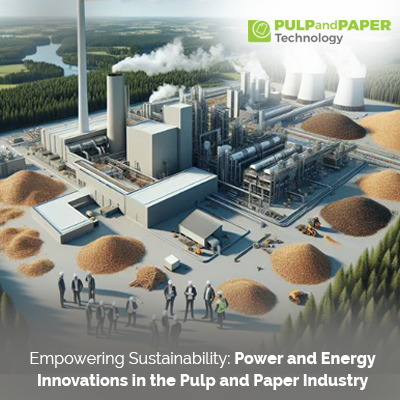Empowering Sustainability: Power and Energy Innovations in the Pulp and Paper Industry

In today's rapidly changing world, the push for sustainability has become more important than ever. And one industry that's been working hard to answer the call is the pulp and paper industry. With advancements in technology and a growing awareness of environmental responsibility, this industry is embracing power and energy innovations to create a greener future.
The Importance of Sustainability in the Industry
The pulp and paper industry has long been associated with environmental concerns due to the high energy consumption and carbon emissions associated with its manufacturing processes. However, in recent years, there has been a significant shift towards sustainability in the industry. This shift is driven by a combination of consumer demand for eco-friendly products, regulatory pressures, and the industry's own recognition of the need to reduce its environmental impact.
By adopting sustainable power and energy innovations, pulp and paper companies are not only reducing their carbon footprint but also gaining a competitive edge in the market. Consumers are increasingly conscious about environmental issues and are more likely to choose products from companies that demonstrate a commitment to sustainability. This trend has led to increased demand for eco-friendly paper and packaging materials, creating new business opportunities for companies that embrace sustainable practices.
Power and Energy Consumption in the Pulp and Paper Industry
The pulp and paper industry is energy-intensive, with significant power requirements for various stages of the manufacturing process. From the pulping of raw materials to the drying and finishing of paper products, energy consumption is a critical aspect of the industry's operations. Traditionally, the industry has relied heavily on fossil fuels, such as coal and oil, to meet its energy needs. However, this reliance on non-renewable energy sources has come under scrutiny in recent years.
To address this issue, the industry is exploring alternative energy sources that are both environmentally friendly and economically viable. One such source is renewable energy, which includes wind, solar, and biomass power. By harnessing these renewable resources, pulp and paper companies can significantly reduce their carbon emissions and dependence on fossil fuels.
Innovations in Renewable Energy Sources
Renewable energy sources hold great potential for the pulp and paper industry to transition towards a more sustainable future. Wind power, for example, is being harnessed by companies to generate electricity for their manufacturing operations. By installing wind turbines in suitable locations, these companies can tap into a clean and abundant source of energy while reducing their reliance on grid electricity.
Solar power is another promising renewable energy source that is being adopted by the industry.
Solar panels are installed on the roofs of manufacturing facilities to generate electricity from sunlight. This energy can be used to power various stages of the production process, reducing the need for grid electricity and further lowering carbon emissions.
Biomass power is also gaining traction within the industry. Biomass, such as wood waste and agricultural residues, can be converted into energy through processes like combustion or gasification. This renewable energy source not only reduces reliance on fossil fuels but also helps in the efficient management of waste materials generated by the industry.
Energy-Efficient Technologies in the Industry
In addition to embracing renewable energy sources, the pulp and paper industry is also investing in energy-efficient technologies to optimize its power consumption. These technologies aim to reduce energy wastage and improve overall process efficiency, leading to significant cost savings and environmental benefits.
One such technology is cogeneration, also known as combined heat and power (CHP). Cogeneration systems allow pulp and paper mills to simultaneously produce electricity and useful heat from the same energy source, such as biomass. This process maximizes the efficiency of energy utilization, as the waste heat generated during electricity production is captured and used for heating or other industrial processes.
Another energy-efficient technology gaining popularity in the industry is advanced process control (APC). APC systems use real-time data and sophisticated algorithms to optimize process parameters, such as temperature, pressure, and flow rates. By fine-tuning these parameters, mills can minimize energy consumption and improve product quality, all while reducing their environmental impact.
Government Regulations and Incentives for Sustainable Practices
Government regulations and incentives play a crucial role in driving the adoption of sustainable power and energy solutions in the pulp and paper industry. Many countries have implemented strict environmental regulations to limit carbon emissions and promote sustainable practices. These regulations often include penalties for non-compliance and provide incentives for companies that go above and beyond the minimum requirements.
In addition to regulations, governments also provide financial incentives to encourage the adoption of renewable energy and energy-efficient technologies. These incentives can take the form of tax credits, grants, or low-interest loans, making it more economically viable for companies to invest in sustainable power and energy innovations.
By aligning their sustainability initiatives with government regulations and taking advantage of available incentives, pulp and paper companies can accelerate their transition towards a greener and more sustainable future.
Challenges and Barriers to Implementing Sustainable Power and Energy Solutions
While the adoption of sustainable power and energy innovations in the pulp and paper industry is gaining momentum, there are still several challenges and barriers that need to be addressed.
One significant challenge is the upfront cost of implementing renewable energy and energy-efficient technologies. While these investments often yield long-term cost savings, the initial capital outlay can be a barrier for some companies, particularly small and medium-sized enterprises. Access to financing options and government incentives can help overcome this challenge and encourage broader adoption of sustainable practices.
Another barrier is the complexity of integrating renewable energy sources into existing manufacturing processes. The intermittent nature of renewable energy, such as wind and solar power, requires careful planning and coordination to ensure a stable and reliable energy supply. This integration process may involve significant changes to existing infrastructure and require specialized expertise, which can pose challenges for companies with limited resources.
Furthermore, the availability of suitable locations for renewable energy installations can also be a constraint. Not all regions have favorable wind or solar conditions, which can limit the feasibility of certain renewable energy projects. Overcoming this barrier may require collaborations between companies, governments, and other stakeholders to identify and develop renewable energy resources in the most suitable locations.
The Future of Sustainability in the Pulp and Paper Industry
Looking ahead, the future of sustainability in the pulp and paper industry appears promising. As technology continues to advance, renewable energy sources are becoming more efficient and cost-effective. This trend, coupled with growing consumer demand for eco-friendly products, will likely drive further innovation and investment in sustainable power and energy solutions.
The industry's commitment to sustainability is not only driven by external pressures but also by a genuine desire to create a better future. By embracing power and energy innovations, the pulp and paper industry is positioning itself as a leader in sustainability, contributing to a greener planet while ensuring long-term success.
Conclusion:
The pulp and paper industry is undergoing a profound transformation towards sustainability, driven by advancements in power and energy innovations. By harnessing renewable energy sources and adopting energy-efficient technologies, companies in this industry are reducing their carbon footprint, meeting consumer demands, and gaining a competitive edge in the market.
While challenges and barriers remain, the industry's commitment to sustainability is unwavering. Government regulations and incentives, along with collaborations between companies and other stakeholders, will play a crucial role in overcoming these challenges and accelerating the adoption of sustainable power and energy solutions.
In the pursuit of empowering sustainability, the pulp and paper industry is not only transforming its own operations but also inspiring change in other sectors. By embracing power and energy innovations, this industry is proving that it is possible to balance economic growth with environmental responsibility, creating a greener and more sustainable future for generations to come.








